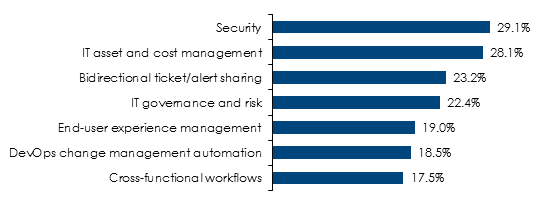ServiceOps: ITSM and ITOps Move from
Cooperation to Collaboration
by Valerie O'Connell, Research Director, EMA
Nothing drives IT change like…change. There has been plenty of that to go around in the past few years. Planned digital transformation initiatives turbocharged into accelerated implementation as employees working from anywhere raised the stakes of day-to-day IT operations to business-critical levels.
Complexity, criticality, and the velocity/volume of change transformed AI/ML and automation from pilots into survival essentials. In response, enterprises increasingly turned to platforms for AI-enabled end-end visibility, workflows, and action.
It stands to reason that all of these changes would drive advances in how the core functions of IT service and IT operations work together. EMA undertook a deep dive research project with 400+ global IT leaders to understand the practical realities of IT ServiceOps today and in the near future.
Spoiler alert: Part technology and organizational approach, ServiceOps by any name will become the prevailing IT operational model because it is practical and makes good business sense.
Staffed by very different talent profiles aimed at distinct spheres of responsibility, the two groups traditionally interacted only when absolutely required by circumstances such as outages and changes required by DevOps. Today, the notion of ServiceOps represents the growing fact that in a healthy enterprise, it is increasingly difficult to say where one function ends and another begins. It’s all about IT service to the business, and there is no service without effective IT operations.
Execution and service are inextricable.
It turns out that organizational siloes can be just as deadening as siloed toolsets and systems. The combination of AI and automation can mitigate both. Automation, AI/ML/analytics, and platforms that welcome cross-functional workflows make cooperation a practical reality. The research panel covered a lot of ground when asked,
How do IT operations and ITSM collaborate using AI/ML and automation?
In this converged reality, both ITOps and ITSM take advantage of mutually beneficial solutions that are aimed at and measured by business goals. The long-heralded IT/business alignment is a natural byproduct of cross-functional capabilities, as well as a prerequisite to effective IT automation.
ITSM and ITOps remain distinct functions with specific charters. However, shared technology softens the boundaries and moves them closer organizationally. The research showed very strong correlation between the degree to which IT service and operations collaborate using AI-enabled automation and self-reported quality of IT service, end-user experience, business innovation, and increased IT budget.
ServiceOps, by whatever name, will soon be the prevailing IT operational model. It is the logical product of common sense and technology combined for practical purposes. Both IT service and IT operations have to be at the top of their respective games. Hitting that mark calls for platform-enabled, AI-assisted automation that flexibly connects people and machines across the enterprise.
Digital transformation, business innovation, and a world filled with surprises guarantee a constant state of change in IT. With a heavy assist from technology, the ServiceOps model positions IT to be organizationally as responsive and agile as the business demands.
ADDITIONAL RESOURCES:
- Details of these research findings are covered in a 30-minute vendor-neutral on-demand webinar
- A one-hour interactive session on the same topic hosted by ServiceNow is scheduled for May 19
- 18 page ebook on the ServiceOps research